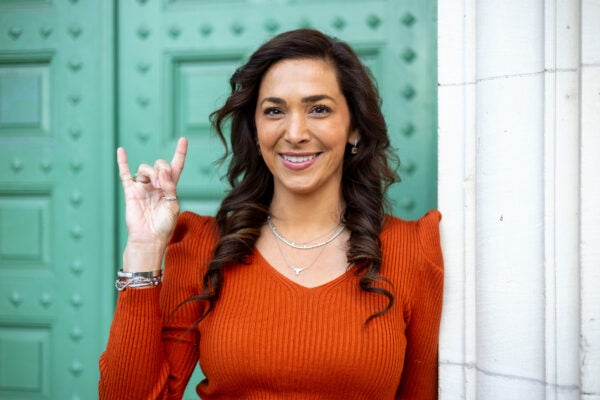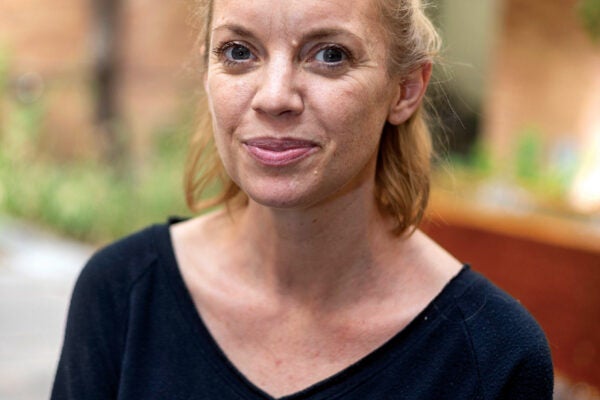Sarita Brown attended The University of Texas at Austin in the 1970s, a time when the Armadillo World Headquarters helped establish Austin as a live music capital and bell-bottom pants rocked the fashion world. At this same time, Brown and many students at UT Austin, especially those who weren’t white, knew hardship and often felt like they didn’t belong.
Regardless of the challenges, Brown knew she needed a degree. Both her parents emphasized the importance of attending college. Her father, a Mexican immigrant, left school in the third grade, and her mother had only a high school diploma.
Brown pursued degrees in communication and ethnic studies. Her coursework brought her to a Chicano studies class that, she says, opened her eyes. Working with Américo Paredes, the founder of the Center for Mexican American Studies, Brown could see the parallels between figures from history and those in the present day who work to make a place for themselves. She went on to earn her master’s at UT and then worked for 15 years to diversify graduate education by building the Graduate Opportunity Program in the Office of Graduate Studies.
Decades after her time as a student, the university that Brown knew was by no means perfect, but it had changed for the better, and efforts to make UT a more welcoming place for its Hispanic population had grown and solidified. In fall 2020, UT Austin joined 13 other institutions that have earned the Seal of Excelencia, a certification by Excelencia in Education, a nonprofit co-founded by Brown, which honors a university’s commitment to serving the Latino student population.
“It’s not about being a Hispanic-enrolling institution,” says Rachelle Hernandez, senior vice provost for enrollment management and student success. “It’s about being a Hispanic-serving institution, and the construct for a Hispanic-serving institution is that by serving our Latinx or Hispanic students well, we’re serving all of our students well.”

Earlier that year, Hernandez and Luis Zayas, dean of the Steve Hicks School of Social Work, became co-chairs for the Hispanic Serving Institution (HSI) Transition Committee, an inaugural committee of the university’s recruitment and retention inclusion effort, which was created to prepare for UT Austin’s status as an HSI. As determined by the Higher Education Act, HSIs are colleges and universities with Hispanic student enrollment of at least 25%, a level of enrollment that UT Austin reached last fall. Recognition by the Department of Education as HSI-grant eligible would enable the university to apply for specific federal resources that could then be used toward student support on campus.
Many universities achieve this status purely based on demography. For example, institutions in the Rio Grande Valley are able to surpass 25% Hispanic enrollment because more than 80% of the population in the region is Hispanic and the enrollments reflect the populations, College of Liberal Arts professor Deborah Parra-Medina says. This does not necessarily mean that the institution has implemented programs or strategies to better serve their Hispanic students. Before UT Austin reached the HSI enrollment-based threshold, Hernandez, Zayas and the rest of the HSI Transition Committee wanted to build upon, enhance and support campus efforts to develop Hispanic-serving strategies. Part of the process of demonstrating the university’s commitment began with obtaining the Seal of Excelencia. The seal framework is being used as the foundation for campus efforts.
The Seal says, ‘OK, you’re on the right track. You’ve arrived, but you’ve got a lot of work to do.
The Seal of Excelencia announced its first cohort of universities in June 2019, which included El Paso Community College, Austin Community College and the University of Arizona. Selected colleges earn the seal by building a framework to serve Latino students through leadership, data and practice. For each of the selected institutions, these criteria include collecting data on Latino students and creating plans for students, faculty and staff members on how to improve numbers such as student enrollment, student retention and degree completion.
“The seal says, ‘OK, you’re on the right track. You’ve arrived, but you’ve got a lot of work to do,’” Zayas says. “It is not going to be like we get the Michelin star at a restaurant and stop good cooking. No, we’re just getting this seal, and that’s the beginning of improving ourselves and finding every way to serve the entire university.”
Initiatives so far have been informed by data. The committee at UT has looked at discrepancies between Hispanic student acceptances into the university versus the number of students who ultimately choose to enroll. When Parra-Medina, co-chair for the faculty engagement subcommittee, examined the data, she found that just more than half of accepted Hispanic students were enrolling, making it the lowest ratio compared to other demographics. Parra-Medina says this might be due to economics because UT could be less attractive to students who are entertaining generous financial aid packages and merit awards from other elite universities. This situation plays into the Texas Advance Commitment, an initiative started in 2018 in which the university pays tuition for students with a family income up to $65,000 and provides some assured financial aid for students with a family income up to $125,000.
Another factor is students not wanting to live far from family. To help foster a relationship between UT and prospective students, the committee has worked on targeted campaigns to families.
In terms of current students, the committee looks at retention rates and graduation rates to see how Hispanic students are faring on campus. To help students feel connected and at home with the university, UT offers 360 Connections, an initiative that includes programming such as First-Year Interest Groups and honors societies.
“These are initiatives that try to work with the student, identify students that potentially might be at risk and give them extra support early, so that we can retain them and have them complete their degrees,” Parra-Medina says.

The faculty engagement subcommittee hopes to involve faculty members across the university and support them in their work to enhance Latino student success on campus. Parra-Medina, who works as the inaugural director of the Latino Research Institute and a professor in the Department of Mexican American and Latina/o Studies, says she is used to applying her research and scholarship and working with her highly diverse colleagues and students. She cannot say whether this is the same experience across all schools, but she wants to be able to support the values of service toward student success across the university.
Going forward, all HSI Transition Committee subcommittees are organizing three-year plans to continue strategizing their work. As they do so, UT awaits official designation of eligibility for HSI grants, since the Department of Education uses older data in its calculations. It could be about two years before UT becomes eligible for HSI funding.
Until then, Brown is preparing to send her own daughter off to college. If her family didn’t live in Virginia, she says, she would be pushing her daughter toward her alma mater. Regardless of where her daughter ends up going to school, Brown knows her own father’s dream has been achieved. Brown’s daughter does not have to question if she’s going to college. Instead, she’s debating where to attend.
“This is just beginning,” Brown says. “I want this to be the beginning of what we will build together, all 14 of these institutions, Excelencia and the momentum of those who believe in the future. And the future includes all because, when we do that, then the richness that we all talk about will be plentiful.”



